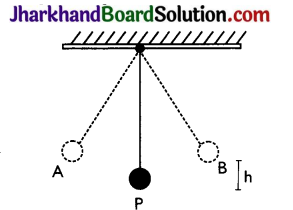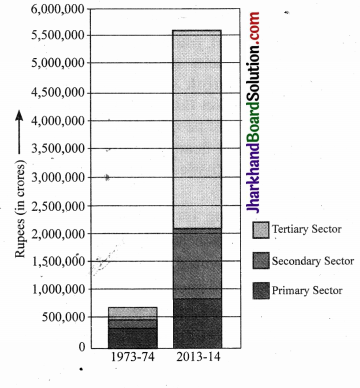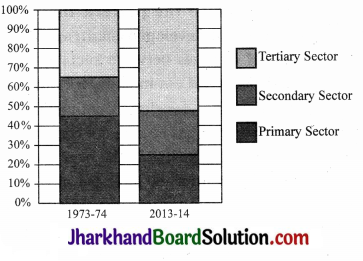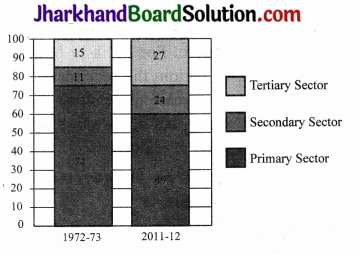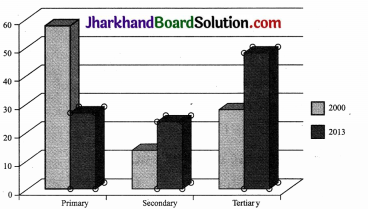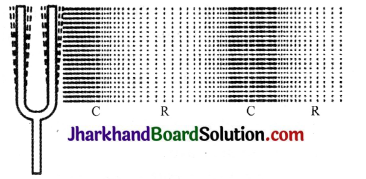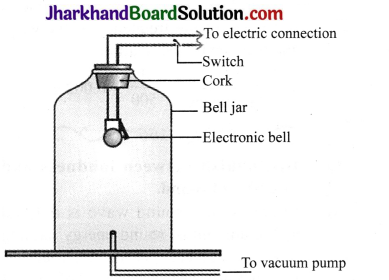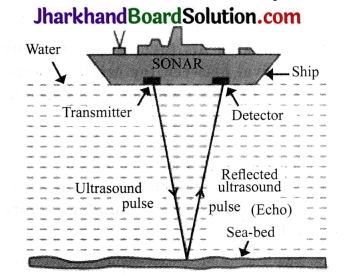JAC Board Class 10th Social Science Solutions Economics Chapter 1 Development
JAC Class 10th Economics Development InText Questions and Answers
Question 1.
Why do different persons have different notions of development? Which of the following explanations is more important and why?
(a) Because people are different.
(b) Because life situations of persons are different.
Answer:
Life situations of different persons are different hence have different notions of development. Development goals of a landless farmer are different from prosperous farmer in Punjab. It is because their lifestyle, situations and status are very different from each other. With changing situations the goal of a person also changes.
![]()
Question 2.
Do the following two statements mean the same? Justify your answer.
(a) People have different developmental goals.
(b) People have conflicting developmental goals.
Answer:
The above mentioned two statements means almost the same, as different persons could have different as well as conflicting developmental goals. For instance, an industrialist may favour construction of dam for electricity generation, while the locals may oppose large dams as this may submerge the land and disrupt the lives of the people.
Question 3.
Give some examples where factors other than income are important aspects of our lives.
Answer:
Income in one way or the other is an important aspect of our lives; however people also seek things like freedom, equal treatment, security, and respect of others. They resent discrimination. Women desire respect and secure environment to take up diverse jobs or set up businesses. People
also seek political freedom and a healthy pollution free environment.
Question 4.
Explain some of the important ideas of the above section in your own words.
Answer:
The above section highlights that development goals are different for every individual. Even national goals are different for every individual. Income is an important aspect of everyone’s life however, money or materialistic aspirations are not that every individual desires. People also seek better quality of life, environment, freedom, security, respect from others and equal treatment.
Page 7
Question 5.
Look at the picture. What should be the developmental goals for such an area?
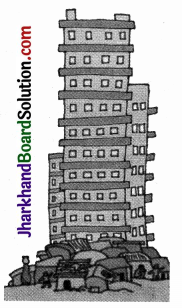
Answer:
The developmental goals of this area should include:
- Making pucca houses for the occupants of the slums with proper toilet facilities.
- Availability of basic services like water, electricity and sanitation.
- Employment opportunites for the people to ensure that they can earn better living environment for themselves.
![]()
Question 6.
Read the newspaper report and answer the questions that follow:
A vessel dumped 500 tonnes of liquid toxic wastes into open – air dumps in a city and in the surrounding sea. This happened in a city called Abidjan in Ivory Coast, a country in Africa. The fumes from the highly toxic waste caused nausea, skin rashes, fainting, diarrhoea etc. After a month seven persons were dead, twenty in hospital and twenty – six thousand treated for symptoms of poisoning. A multi – national company dealing in petroleum and metals had contracted a local company of the Ivory Coast to dispose the toxic waste from its ship.
(a) Who are the people who benefited and who did not?
(b) What should be the developmental goal for this country?
Answer:
The local company who was supposed to dispose the waste benefitted as they got the money to dispose the waste from the multinational company.
(a) The people of Abidjan in Ivory Coast were badly impacted due to open – air waste disposal.
(b) The developmental goal would be to make people aware about the causes and effects of pollution. Also provisions should be made for proper waste disposal to avoid similar environmental and health crises.
Question 7.
What can be some of the developmental goals for your village, town or locality?
Answer:
The developmental goal for our village, town or locality depends on the present situation. However, better farming facilities, employment opportunities and availability of basic services like schools, hospitals, electricity and good connectivity are general goals for a village. Increase in per capita income, better infrastructure, housing and better security are other developmental goals. aspired by people of towns.
Question 8.
Give three examples where an average is used for comparing situations.
Answer:
Average is used to compare income of two countries. Average is also used to compare the life expectancy level of countries. Average can also be used to study pass percentage of girls and boys in a class or a school.
Question 9.
Why do you think average income is an important criterion for development? Explain.
Answer:
Average income is an important criterion for development because if a country’s per capita income is high, it can be expected that the living standard of its people will also be better. With better income people can earn better living facilities for themselves and even the country prospers.
Question 10.
Besides size of per capita income, what other property of income is important in comparing two or more societies?
Answer:
Besides per capita income the other important criterion for comparing two or more societies is the distribution of. income among the people. If the income is well distributed then every individual will benefit and the country or society will prosper. However, if higher – income is enjoyed by selected people then the societies don’t develop.
![]()
Question 11.
Suppose records show that the average income in a country has been increasing over a period of time. From this, can we conclude that all sections of the economy have become better? Illustrate your answer with an example.
Answer:
The rising average income of a country cannot guarantee all sections of the economy to do better. For instance in a country like India though the per capita income is increasing due to improving service sector and manufacturing sector but agriculture and rural economy is yet to develop fully.
Question 12.
From the text, find out the per capita income level of low – income countries as per World Development Reports.
Answer:
As per World Development Reports countries with per capita income of US $ 12,056 per annum and above in 2017, are called rich countries and those with per capita income of US $ 955 or less are called low – income countries.
Question 13.
Write a paragraph on your notion of what should India do, or achieve, to become a developed country.
Answer:
India to become a developed nation need to achieve the following:
- better economy with higher per capita income and employment opportunity,
- developed rural economy,
- better infrastructure in the rural areas as well as in urban areas,
- education facilities for all,
- better health facilities,
- access to basic facilities like food, shelter, clean water for all.
- last but not the least a healthy clean environment.
Page 12
Question 14.
Look at data in Tables 1.3 and 1.4. Is Haryana ahead of Kerala in literacy rate, etc., as it is in terms of per capita income?
Table 1.3. Per Capita Income of Select States
| State | Per Capita Income for 2015-16 (in |
| Haryana | 1,62,034 |
| Kerala | 1,40,190 |
| Bihar | 31,454 |
Table 1.4. Some Comparative Data on Haryana, Kerala and Bihar
| State | Infant Mortality Rate per 1,000 live births (2016) | Literacy Rate (%) (2011) | Net Attendance Ratio (per 100 persons) secondary stage (age 14 and 15 years) 2013 – 2014 |
| Haryana | 33 | 82 | 61 |
| Kerala | 10 | 94 | 83 |
| Bihar | 38 | 62 | 43 |
Answer:
Yes, Haryana was ahead of Bihar m literacy rate as well as net attendance ratio for class 1 – 5 as in terms of the per capita income.
Question 15.
Think of other examples where collective provision of goods and services is cheaper than individual provision.
Answer:
Collective provision of goods and services gets cheaper when production is done at mass scale or services are delivered at large scale. Such as in manufacturing industries if production is done on a large scale then the cost of product can be minimized, if production is done for individual provision then cost of the product can rise. Collective provision of goods and services are meant for public consumption.
Question 16.
Does availability of good health and educational facilities depend only on amount of money spent by the government on these facilities? What other factors could be relevant?
Answer:
The availability of good health and educational facilities to a large extent depend on the amount of money spent by the government, quality of doctors and teachers are also relevant factors. Qualified good doctors and teachers can scale up the standard of the health and educational sectors. Even contribution of private sector or investment by private sector in this field is also very relevant. Investment by private sector would lead to competition, which ultimate lead to better facilities at reasonable cost.
![]()
Question 17.
In Tamil Nadu, 90 percent of the people living in rural areas use a ration shop, whereas in West Bengal only 35 percent of rural people do so. Where would people be better off and why?
Answer:
Ration shops provide good quality food grains and other items at reasonable rate. Hence, the state, Tamil Nadu in this example with more people availing the facilities will be better off than the people at West Bengal.
Page 12
Question 18.
Study Table 1.5 carefully and fill in the blanks in the following paragraphs. For this, you may need to make calculations based on the table.
Table 1.5. Educational Achievement of Rural Population in Uttar Pradesh
| Category | Male | Female |
| Literacy rate for rural population | 76% | 54% |
| Literacy rate for rural children in age group 10 – 14 years | 90% | 87% |
| Percentage of rural children aged 10 – 14 attending school | 85% | 82% |
(a) The literacy rate for all age groups, including young and old, is ……….. for rural males and ………… for rural females. However, it is not just, that these many adults could not attend school but that there are ………… who are currently not in school.
(b) It is clear from the table that ……….. % of rural girls and ………… % of rural boys are not attending Therefore, illiteracy among children in the age group 10-14 is as high as ………… % for rural females and ………… % for rural males.
(c) This high level of illiteracy among …………. age group, even after more than 68 years of our independence, is most disturbing. In many other states also we are nowhere near realisation of the constitutional goal of free and compulsory education for all children up to the age of 14, which was expected to be achieved by 1960.
Answer:
(a) The literacy rate for all age groups, including young and old, is 76% for rural males and 54% for rural females. However, it is not just that these many adults could not attend schools but that there are 36% of males and 69% of females who are currently not in school.
(b) It is clear from the table that 69% of rural girls and36% ofruralboys arenot attending schools. Therefore, illiteracy among children in the age group 10 – 14 is as high as 61% for rural females and 32% for rural males.
(c) This high level of illiteracy among 10-14 age group, even after more than 60 years of our independence, is most disturbing. In many other states also we are nowhere near realization of the constitutional goal of free and compulsory education for all children up to the age of 14, which was expected to be achieved by 1960.
JAC Class 10th Economics Development Textbook Questions and Answers
Question 1.
Development of a country can generally be determined by
(a) its per capita income
(b) its average literacy level
(c) health status of its people
(d) all the above
Answer:
(d) all the above
Question 2.
Which of the following neighbouring countries has better performance in terms of human development than India?
(a) Bangladesh
(b) Sri Lanka
(c) Nepal
(d) Pakistan
Answer:
(b) Sri Lanka
![]()
Question 3.
Assume there are four families in a country. The average per capita income of these families is ₹ 5000. If the income of three families is ₹ 4000, ₹ 7000 and ₹ 3000 respectively, what is the income of the fourth family?
(a) ₹ 7500
(b) ₹ 3000
(c) ₹ 2000
(d) ₹ 6000
Answer:
(d) ₹ 6000
Question 4.
What is the main criterion used by the World Bank in classifying different countries? What are the limitations of this criterion, if any?
Answer:
- Average income or per capita income is the main criterion used by the World Bank in classifying different countries.
- The limitation of this criterion is that it does not consider how the income is distributed among people of the country.
- This criteria focus on the economic aspect and ignores the other developmental factors such as literacy rate, health status, infant mortality rate etc,. which are important indicators of development.
Question 5.
In what respects is the criterion used by the UNDP for measuring development different from the one used by the World Bank?
Answer:
- World Bank in its World Development Report, used per capita income in classifying countries as developed or less developed.
- As per WDR, countries with per capita income of US $ 12,056 per annum and above in 2017, are called rich countries and those with per capita income of US $ 955 or less are called low – income countries.
- The Human Development Report published by UNDP on the other hand compares countries based on the health status of the people, their educational levels and per capita income.
Question 6.
Why do we use averages? Are there any limitations to their use? Illustrate with your own examples related to development.
Answer:
- Averages are used to compare different factors or entities. For instance, since countries have different populations, just comparing total income cannot tell us what an average person earns.
- Averages have many limitations such as an average does not reveal the true picture regarding the distribution of income or distribution pattern of other factors.
- For example, consider two schools A and B. For easy understanding let’s assumed only female students of class 10th. Based on the data given in the table, let us calculate the average height for both the schools.
| Country
| Height of Class 10th girls student in (2007) | |||||
| I | II | III | IV | V | Average | |
| School A | 120 | 105 | 115 | 100 | 125 | 113 |
| School B | 90 | 90 | 90 | 90 | 205 | 113 |
Question 7.
Kerala, with lower per capita income has a better human development ranking than Punjab. Hence, per capita income is not a useful criterion at all and should not be used to compare states. Do you agree? Discuss.
Answer:
- Per capita income only highlights the economic factor, however factors like literacy rate, mortality rate and Net Attendance ratio are also important human development factors. In these factors Kerala is better than Haryana.
- Hence, due to these advantages, Kerala has a better human development ranking than Haryana, in spite of lower per capita income.
Question 8.
Find out present sources of energy used by people in India. What could be the other possibilities fifty years from now?
Answer:
- At present Indian people have more dependency on non-renewable sources of energy like coal, natural oil and gas.
- With growing awareness and environmental Concerns and India’s agreement in Paris Climatic Convention, the chances are India will be utilizing more of renewable sources of energy such as solar energy, geothermal energy etc.
Question 9.
Why is the issue of sustainability important for development?
Answer:
- Development is desired by everyone, even developed countries aspire to go up further or at least maintain development for future generation, which is possible with sustainable development.
- Sustainable development is possible when all natural resources are judiciously used, so that future generation can also get the opportunity to utilize the resources for their development.
Question 10.
“The Earth has enough resources to meet the needs of all but not enough to satisfy the greed of even one person.” How is this statement relevant to the discussion of development? Discuss.
Answer:
- The earth has enough resources to meet our needs but often humans for the sake of development over utilizes resources, which can leads to environmental degradation.
- Thus this is relevant to say that there is enough to meet the need but not greed.
- For faster or more development humans resorts to activities like excessive utilization of fuels, deforestation, usage of chemicals in the forms of pesticides and fertilizers in farms etc., which leads to environmental degradation and ultimately results in declining development.
Question 11.
List a few examples of environmental degradation that you may have observed around you.
Answer:
Activities such as deforestation, usage of chemical pesticides and fertilizers, excessive burning of fossil fuels, wastage of water and water pollution etc. are few common environmental degradation factors.
Question 12.
For each of the items given in Table 1.6, find out which country is at the top and which is at the bottom. Table 1.6. Some Data Regarding India and Its Neighbours for 2017
| Country | Gross National Income (GNI) per capita (2011 ppp $) | Life expectancy at birth (2017) | Mean years of schooling of people aged 25 and above (2017) | HDI rank in the world (2018) |
| Sri Lanka | 11,326 | 75.5 | 10.9 | 76 |
| India | 6,353 | 68.8 | 6.4 | 130 |
| Myanmar | 5,567 | 66.7 | 4.9 | 148 |
| Pakistan | 5,331 | 66.6 | 5.2 | 150 |
| Nepal | 2,471 | 70.6 | 4.9 | 149 |
| Bangladesh | 3,677 | 72.8 | 5.8 | 136 |
Notes:
- HDI stands for Human Development Index. HDI ranks in above table are out of 189 countries in all.
- Life expectancy at birth denotes, as the name suggests, average expected length of life of a person at the time of birth.
- Per Capita Income is calculated in dollars for all countries so that it can be compared. It is also done in a way so that every dollar would buy the same amount of goods and services in any country.
Answer:
- In Per Capita Income: Sri Lanka is at the top and Bangladesh at the bottom.
- In life expectancy at birth Sri Lanka is at the top and Myanmar is at the bottom.
- In literacy rate for 15+ years population Sri bottom.
Question 13.
The following table shows the proportion of adults (aged 15 – 49 years) whose BMI is below normal BMI < 18.5 kg/m2 in India. It is based on a survey of various states for the year 2015 – 16. Look at the table and answer the following questions.
| State | Male (%) | Female (%) |
| Kerala | 8.5 | 10 |
| Karnataka | 17 | 21 |
| Madhya Pradesh | 28 | 28 |
| All States | 20 | 23 |
(a) Compare the nutritional level of people in Kerala and Madhya Pradesh.
(b) Can you guess why around one- fifth of people in the country are undernourished even though it is argued that there is enough food in the country? Describe in your own words.
Answer:
(a) The nutritional level of the people of Kerala is comparatively higher than Madhya Pradesh for both males and females as. the proportion of undernourished adults is more in Madhya Pradesh.
(b) There is enough food in the country but still many around one – fifth people in the country are undernourished because of the following reasons:
- In most of the states, the Public Distribution System (PDS) does not function properly and the poor people cannot get cheap food items, so they remain undernourished.
- Due to lack of proper health facilities in many parts of the country people remain backward and poor, and are not able to get nutritious food.

